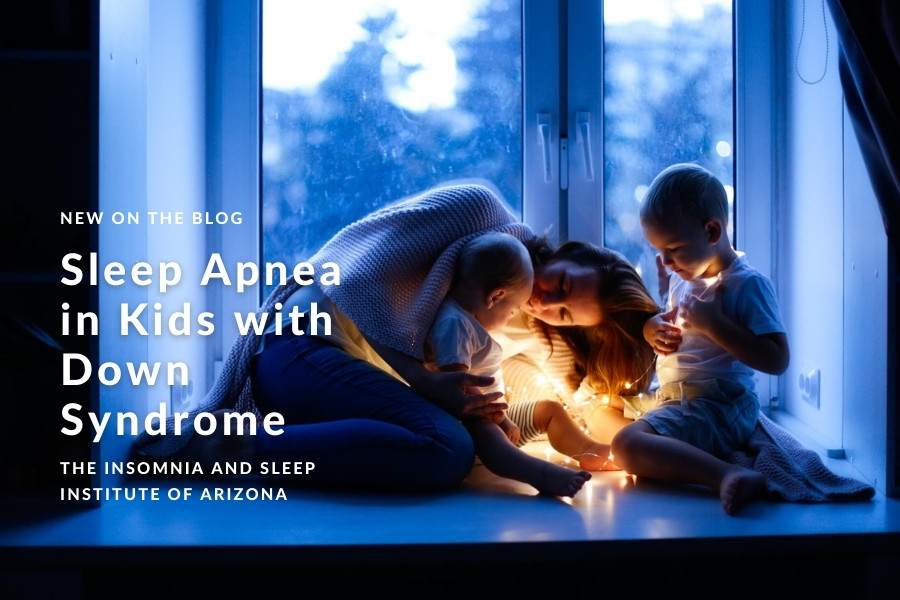Many children with Down Syndrome struggle with sleep apnea, and today there are new methods for diagnosing and treating these young patients. One of the most common reasons patients come to The Insomnia and Sleep Institute of Arizona is because of obstructive sleep apnea (OSA), the most common kind of sleep apnea. It is estimated that up to 79 percent of kids with Down Syndrome have sleep apnea, but there are certain obstacles that can make it a challenge to test this population—and provide successful therapy. The good news is that there have been big innovations in this area that can improve diagnosis and treatment with a home sleep test alternative, rather than relying on the common in-lab polysomnography (PSG). Typically, the PSG is the standard in testing for sleep apnea.
Additionally, the FDA approved the Inspire Medical Systems’ hypoglossal nerve stimulator for kids as young as 13 years old with Down Syndrome. Inspire implants are nothing new to our clinic, but it is new to have the implant approved for younger patients. These kinds of innovations have the potential to lead to lifelong positive benefits because unmanaged OSA in any person can be devastating. It is linked to many chronic disorders including strokes, cardiovascular disease, and early death. For those with Down Syndrome, OSA can also worsen memory, speech, and emotional control.
Catching OSA in Kids with Down Syndrome
It is estimated that many cases of OSA go undiagnosed in every population. However, given the prevalence of OSA in kids with Down Syndrome, the American Academy of Pediatrics recommends a PSG for these patients no later than the age of four. One study of 397 kids with Down Syndrome shows that screening even earlier can be helpful because researchers have found that OSA can be identified in the first year of life. Of course, one of the reasons some children with Down Syndrome don’t get tested for OSA when they should be is because of lack of access to pediatric sleep care. This isn’t the case in our clinic, where we work with patients as young as two years old. Additionally, according to one sleep specialist, “Sometimes—even when there are places and facilities—there may be challenges related to the difficulties due to some of the neurodevelopmental issues that some of these patients have that make it harder for them to undergo any kind of testing, especially something that requires a full night’s stay.”
There have long been home sleep tests available for adults, but all have been designed for adults. This has led to a lack of screening options for kids with Down Syndrome and, in turn, delays in diagnosis and treatment. The limitations of PSG were highlighted in a recent study where parents of children with Down Syndrome said they “overwhelmingly” preferred the home testing system. This study might be pivotal in changing the guidelines regarding OSA treatment and children with Down Syndrome in the coming years.
Unique Issues with OSA and Down Syndrome
There is compliance issues with CPAP therapy for all populations, but especially in those with Down Syndrome. The Inspire implant requires a minor surgery and forces the airway open while the patient sleeps (when necessary). It is controlled by an external remote. In some cases, surgery may be recommended to help with OSA in children with Down syndrome, since these patients have smaller facial bone features, which can be the cause of airway blockage. This is exacerbated when the tonsils are also enlarged.
However, according to the National Down Syndrome Society, it is common for OSA symptoms to persist even after tonsil surgery. In one study, nearly 75 percent of kids who had had this surgery still needed OSA treatment. This traditionally led to CPAP therapy, but compliance requires it to be worn every night for at least four hours. It is an effective treatment for OSA, but only when it is used correctly. CPAP can take some getting used to, especially for those with Down Syndrome who may have certain sensitivities and varying sensations. Before implants, when children with Down Syndrome didn’t get OSA relief from surgery and couldn’t handle CPAP, treatment options ended. That’s no longer the case. Parents have called the Inspire implant a “game changer.”
CPAP Adherence
Another option is to work with a sleep specialist who can provide CPAP modifications that can improve adherence. One recent study showed that changing accessories and working with a sleep team can dramatically improve CPAP adherence. Today, there are many options available for CPAP therapy, and desensitization techniques can be a great help. If your child has Down Syndrome and OSA (or you suspect they have the latter), you deserve a leading sleep specialty team in your corner. Contact The Insomnia and Sleep Institute today by calling the office or filling out the online contact form now.





